
Recipe: Roasted apples, toasted almonds top a thin crust
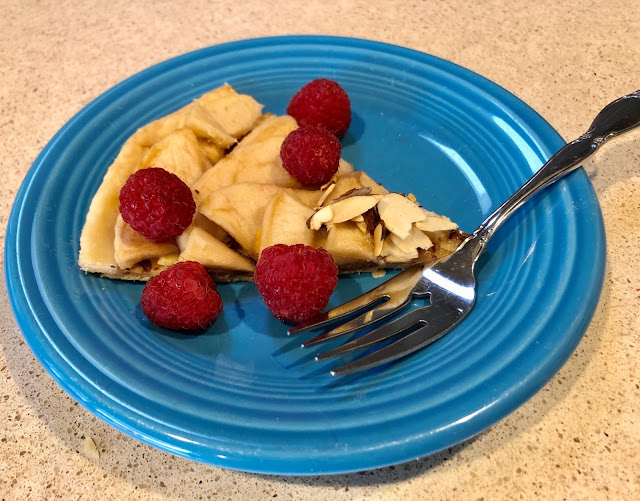 |
| Garnish the tart with fresh fruit or whipped cream, if desired. (Photos: Kathy Morrison) |
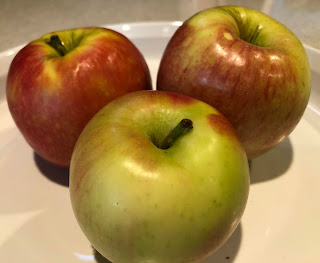
at the farmers markets this month. |
Apples taste so wonderful this time of year, but when baked they often are buried beneath mounds of sugar and cinnamon. Now, I like apple pie as well as the next person, but this tart is a nice change. A no-fuss dessert, it puts the apples front and center. It's also just lightly sweet, so could be served as part of brunch.
The key to this dessert is slow-roasting the apples before they're used in the tart -- an extra step, perhaps, but they can be prepared ahead. The roasting turns the apples "al dente," to borrow a term from pasta cooking, so they're still firm enough to slice but nearly done.
When choosing apples for this recipe, go for sweet-tart varieties, such as Honeycrisp, Empire, Jazz or Braeburn. A mix is nice, too. But Golden Delicious apples would break down too quickly, while Granny Smiths are too tart and too firm for this kind of dessert.
I baked this using a pre-made Pillsbury crust, though with more time I would have made my own pastry. You also could use a puff pastry sheet for a rectangular tart, such as in the Bon Appetit recipe that inspired this adaptation.
Roasted apple tart
Serves 6-8
Ingredients:
1/2 cup sliced almonds
3 sweet-tart apples
1 lemon, halved
1/3 cup maple syrup
2 tablespoons brandy or bourbon (or more maple syrup)
1 teaspoon vanilla extract
Pinch of kosher salt
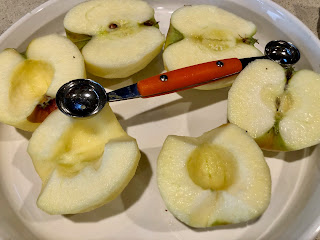
|
1 1/2 tablespoons turbinado or other coarse sugar
1 tablespoon all-purpose flour, plus more for dusting
1 crust for a 9-inch pie, pre-made or homemade
Fresh fruit or whipped cream for garnish, optional
Instructions :
Toast almond slices in a dry, preferably nonstick pan over medium heat, just until some of the slices start to brown and the nuts smell toasty. Pour into a small bowl to cool, and set aside.
Preheat oven to 275 degrees. Peel, halve and core the apples. (A melon ball cutter works nicely to core the seed cavities.) Rub the lemon halves over the apple halves to keep the apples from browning too much. Place the apple halves cut side down in a baking dish that fits them. Squeeze the rest of the juice from the lemon halves over the apples.
In a small bowl, stir together the maple syrup, brandy, vanilla and salt, and add this mixture to the bottom of the baking dish.
Cover the dish tightly with foil. Bake apples 60 to 80 minutes, or until apples are tender but still intact. (Test with a toothpick.) Uncover and let the apples cool while you prepare the crust. You could refrigerate the apples at this point if you're cooking them ahead of time.
Turn oven temperature up to 425 degrees. Remove the pie crust from the refrigerator to let it warm just a few minutes. Meanwhile, stir the sugar into the cooled almond slices. Remove 1 tablespoon of this mixture to reserve for topping, and stir the 1 tablespoon flour into the rest of it.
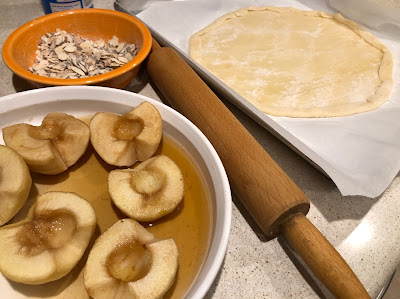
The crust is ready for the filling. The apple halves should be
thinly sliced.
|
Sprinkle a large piece of parchment paper with a little flour. Place the pie crust on it, and cover with another piece of parchment paper. Roll out the crust until it is about 12 inches across. Remove the top paper, and transfer the bottom paper and the crust to a large rimmed baking pan.
Turn the edge of the pie crust over on itself a scant 1/2 inch all around the crust, then push along the back of the rim to make a small ridge. This creates just enough of a crust to hold in the tart ingredients. Brush the edge of the crust with water. (Use a beaten egg white instead, if desired for a glossy edge.)
Sprinkle the nut-flour mixture over the crust. Remove the apples from their dish, reserving the liquid. Thinly slice the apples -- about 1/8-inch-thick -- and arrange the slices over the nuts. Bake the tart for 15 minutes at 425 degrees, then lower the oven temperature to 350 degrees and continue baking until the crust is light golden brown, another 15 to 20 minutes.
While the tart is baking, pour the reserved liquid from the apples into a small nonstick saucepan. Cook the liquid until it starts to thicken, 6-8 minutes, to make the glaze. Let cool. (If it gets too thick, thin with a little hot water or more maple syrup.)
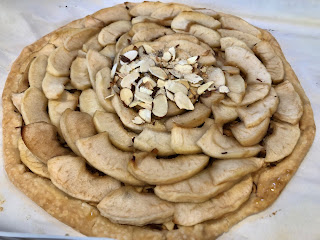
|
| . |
Remove the baked tart to a cooling rack. Brush or drizzle the glaze over the tart. Sprinkle the reserved 1 tablespoon of nuts over the center of the tart, if desired. Serve warm or at room temperature. Leftover tart also reheats well in the microwave
Comments
0 comments have been posted.Sacramento Digs Gardening to your inbox.
Sites We Like
Garden Checklist for week of April 21
This week there’s plenty to keep gardeners busy. With no rain in the immediate forecast, remember to irrigate any new transplants.
* Weed, weed, weed! Get them before they flower and go to seed.
* April is the last chance to plant citrus trees such as dwarf orange, lemon and kumquat. These trees also look good in landscaping and provide fresh fruit in winter.
* Smell orange blossoms? Feed citrus trees with a low dose of balanced fertilizer (such as 10-10-10) during bloom to help set fruit. Keep an eye out for ants.
* Apply slow-release fertilizer to the lawn.
* Thoroughly clean debris from the bottom of outdoor ponds or fountains.
* Spring brings a flush of rapid growth, and that means your garden is really hungry. Feed shrubs and trees with a slow-release fertilizer. Or mulch with a 1-inch layer of compost.
* Azaleas and camellias looking a little yellow? If leaves are turning yellow between the veins, give them a boost with chelated iron.
* Trim dead flowers but not leaves from spring-flowering bulbs such as daffodils and tulips. Those leaves gather energy to create next year's flowers. Also, give the bulbs a fertilizer boost after bloom.
* Pinch chrysanthemums back to 12 inches for fall flowers. Cut old stems to the ground.
* Mulch around plants to conserve moisture and control weeds.
* From seed, plant beans, beets, cantaloupes, carrots, corn, cucumbers, melons, radishes and squash.
* Plant onion sets.
* In the flower garden, plant seeds for asters, cosmos, celosia, marigolds, salvia, sunflowers and zinnias.
* Transplant petunias, zinnias, geraniums and other summer bloomers.
* Plant perennials and dahlia tubers for summer bloom.
* Mid to late April is about the last chance to plant summer bulbs, such as gladiolus and tuberous begonias.
* Transplant lettuce seedlings. Choose varieties that mature quickly such as loose leaf.